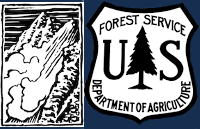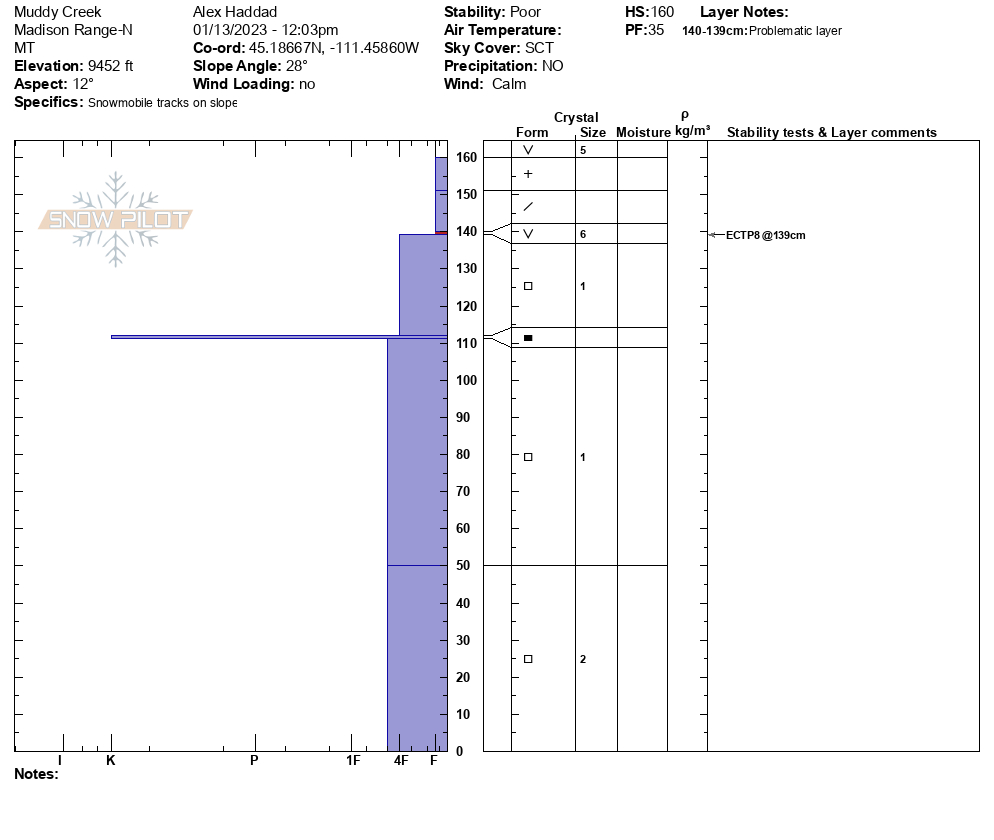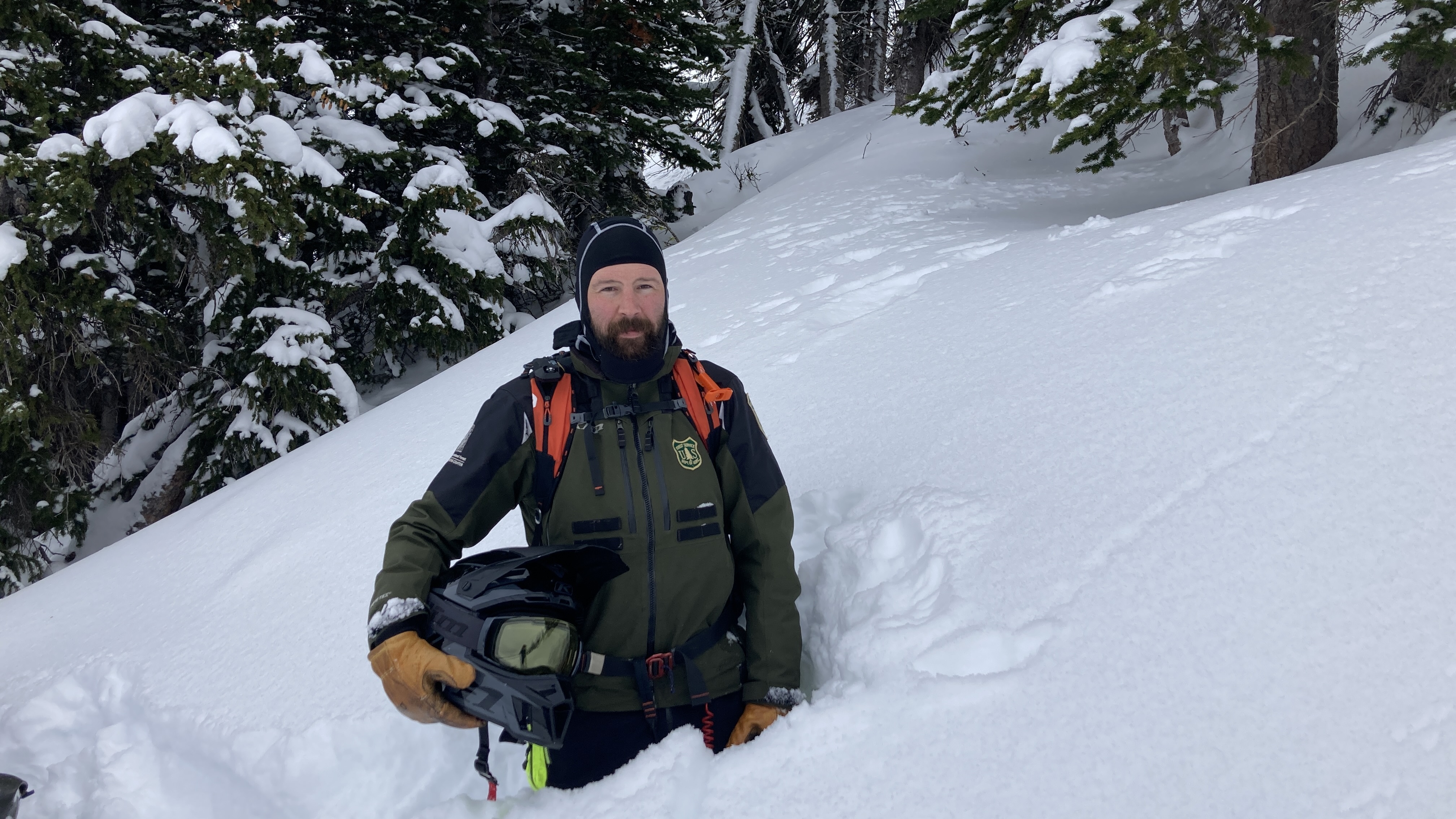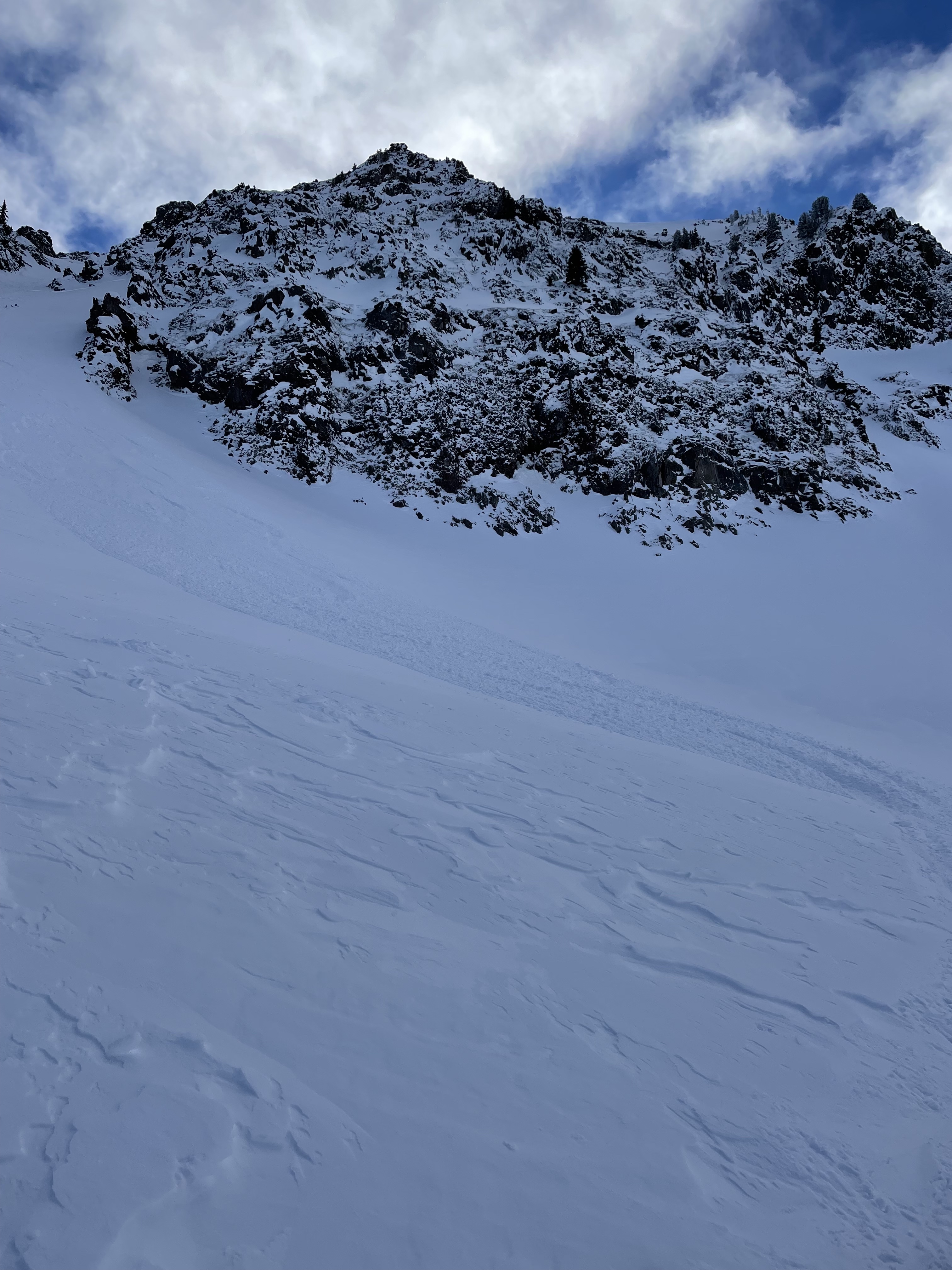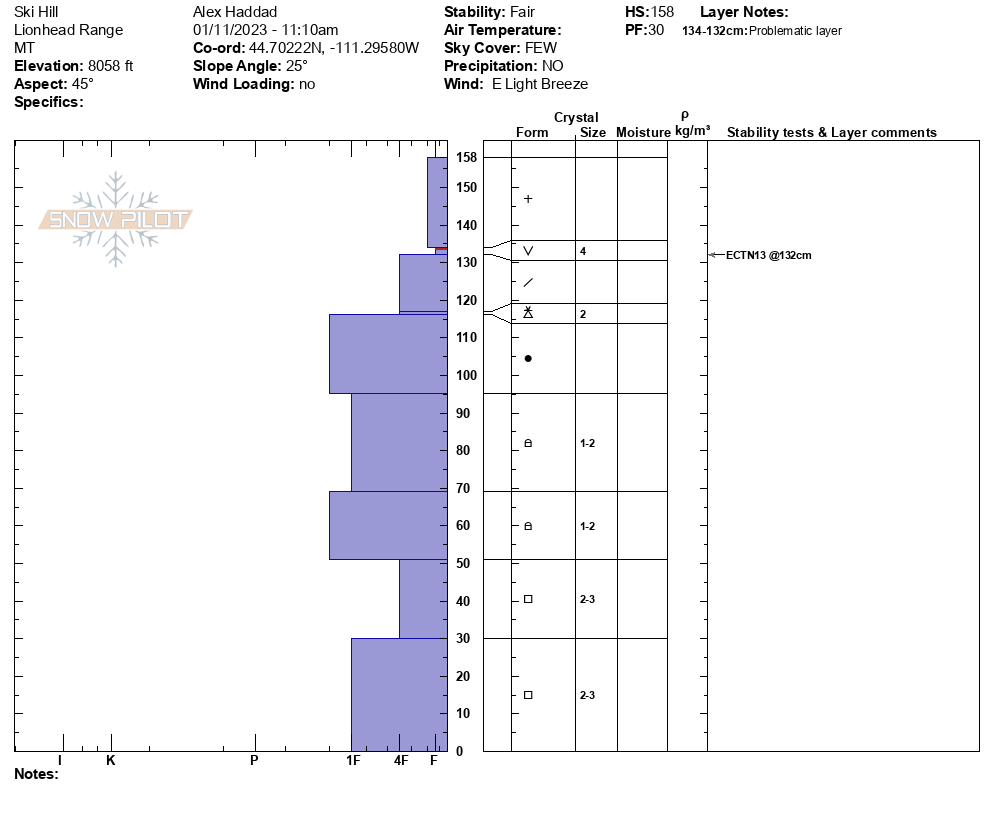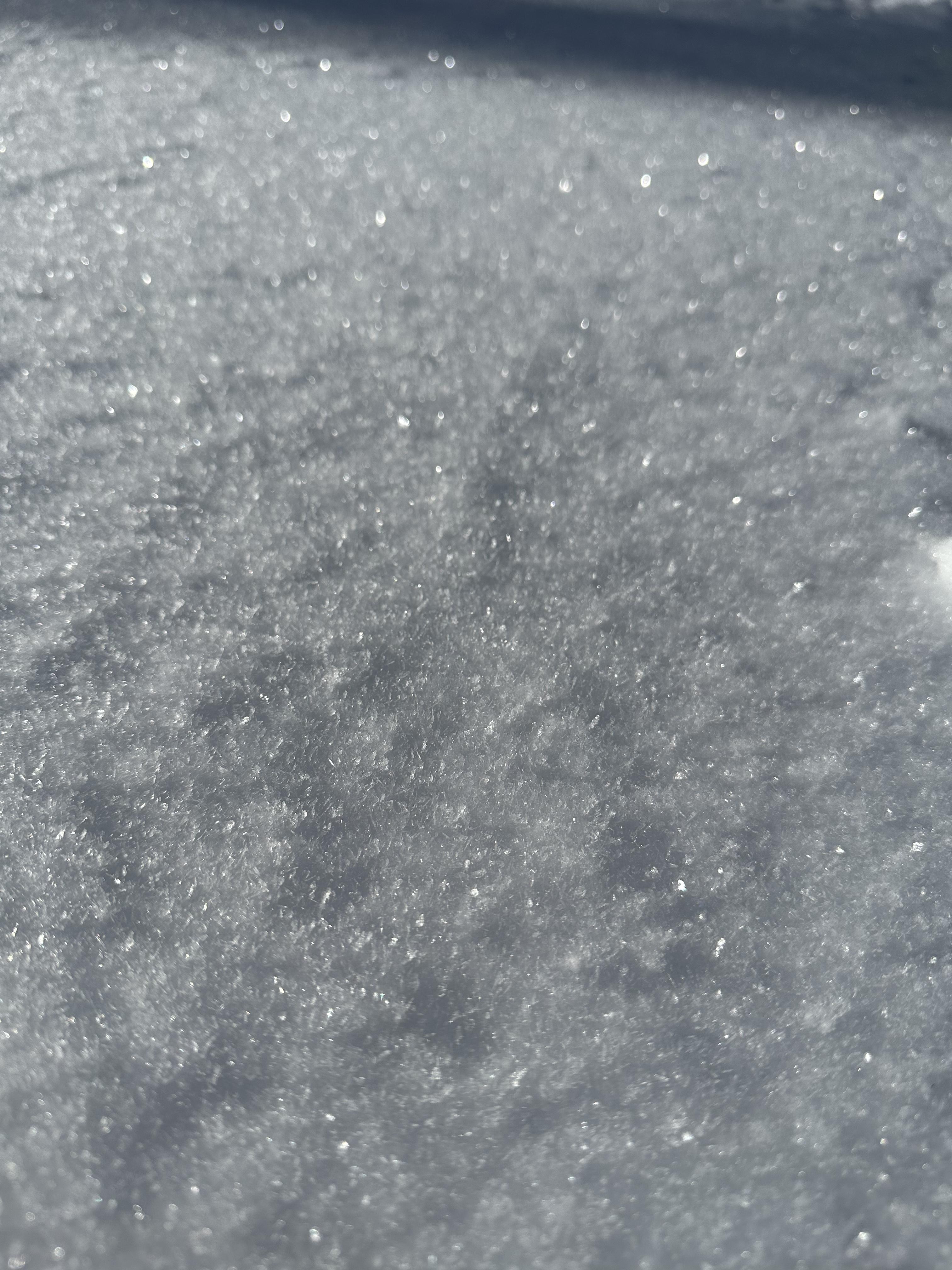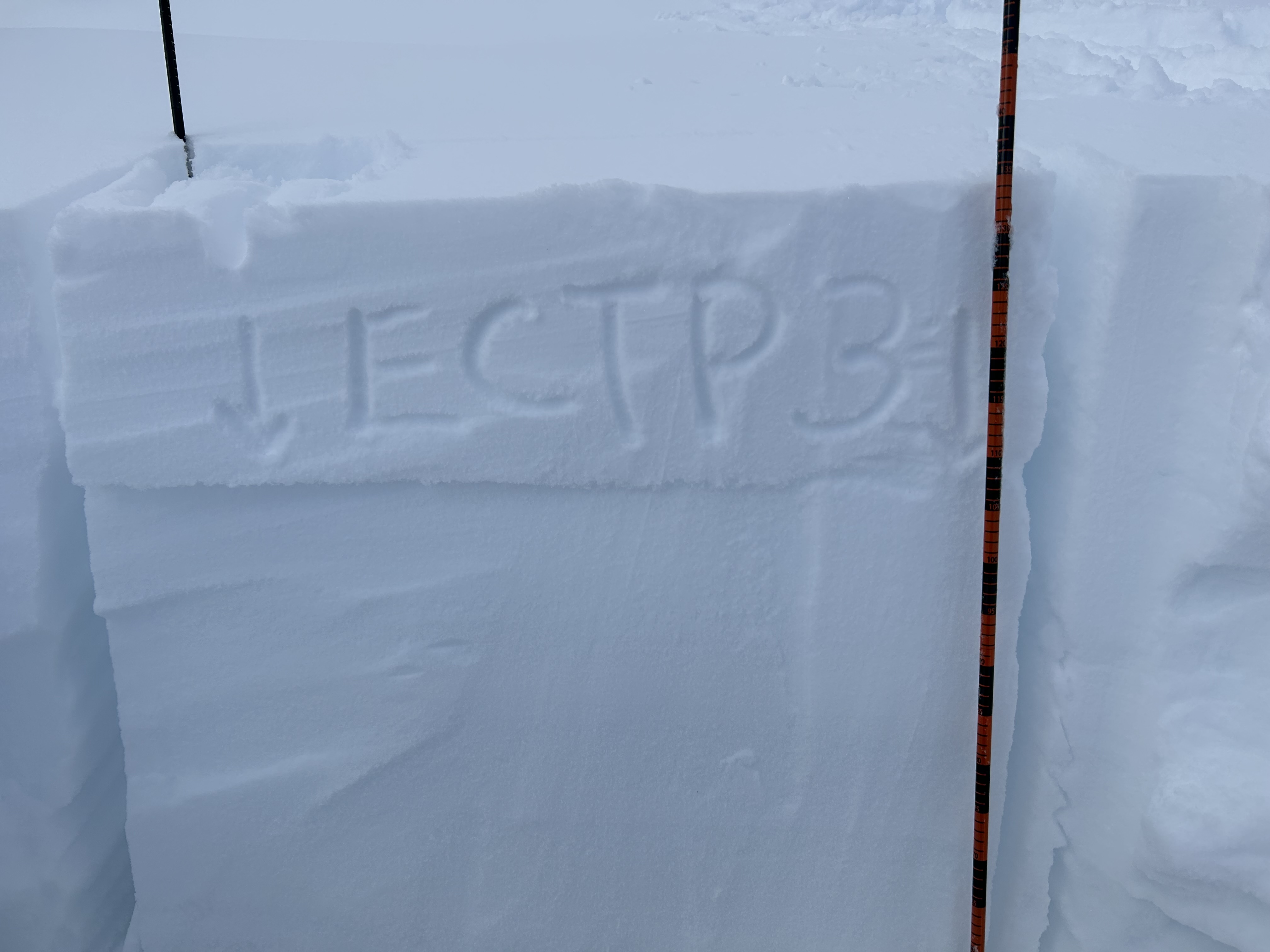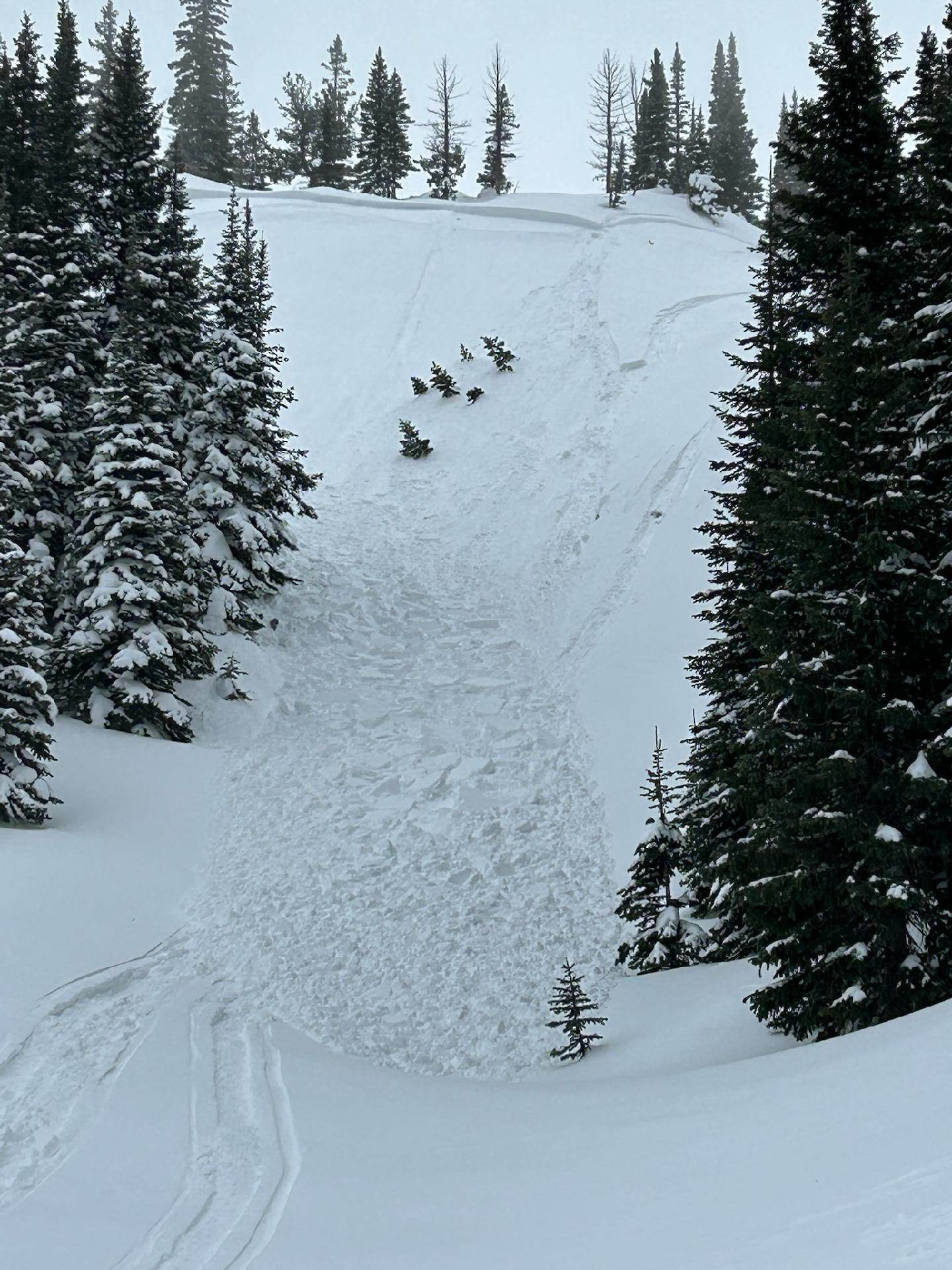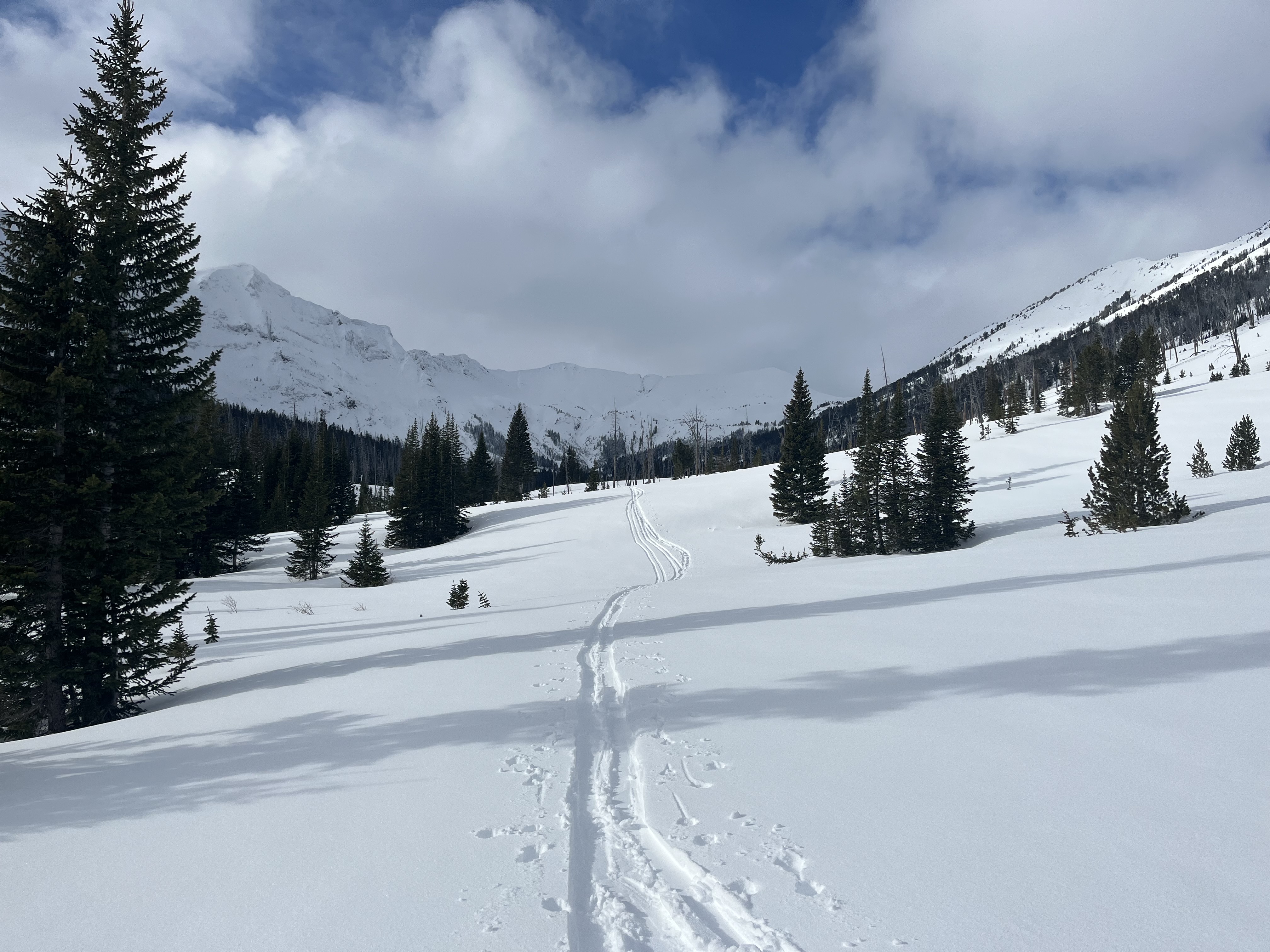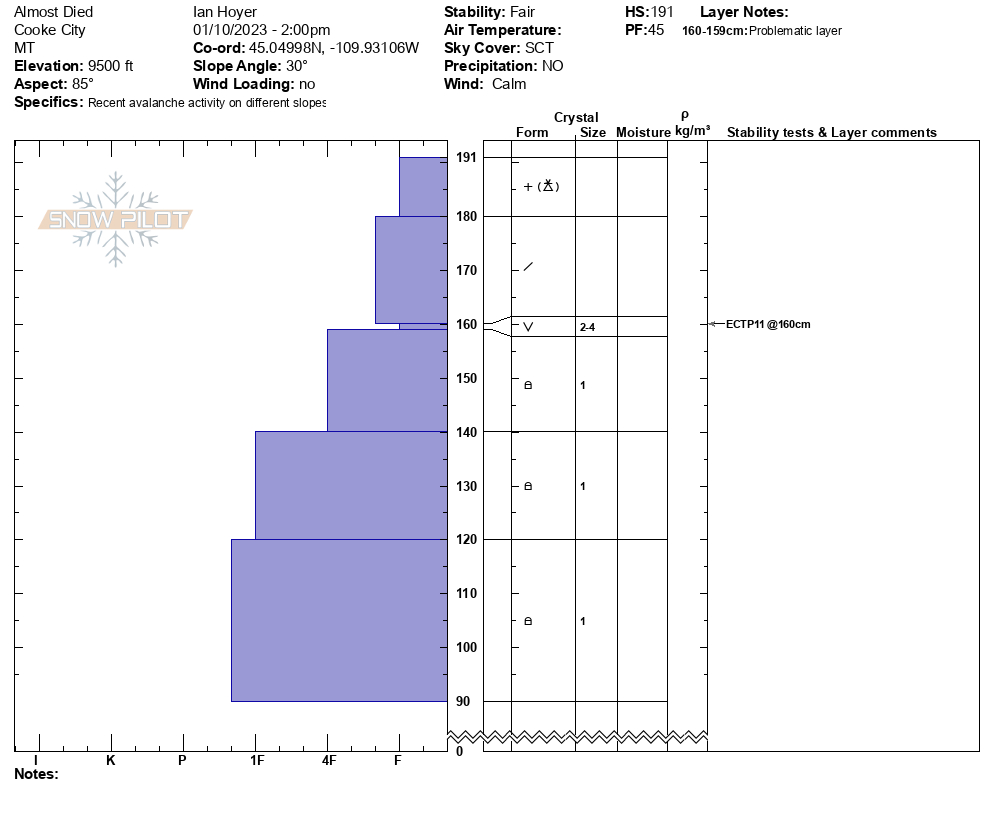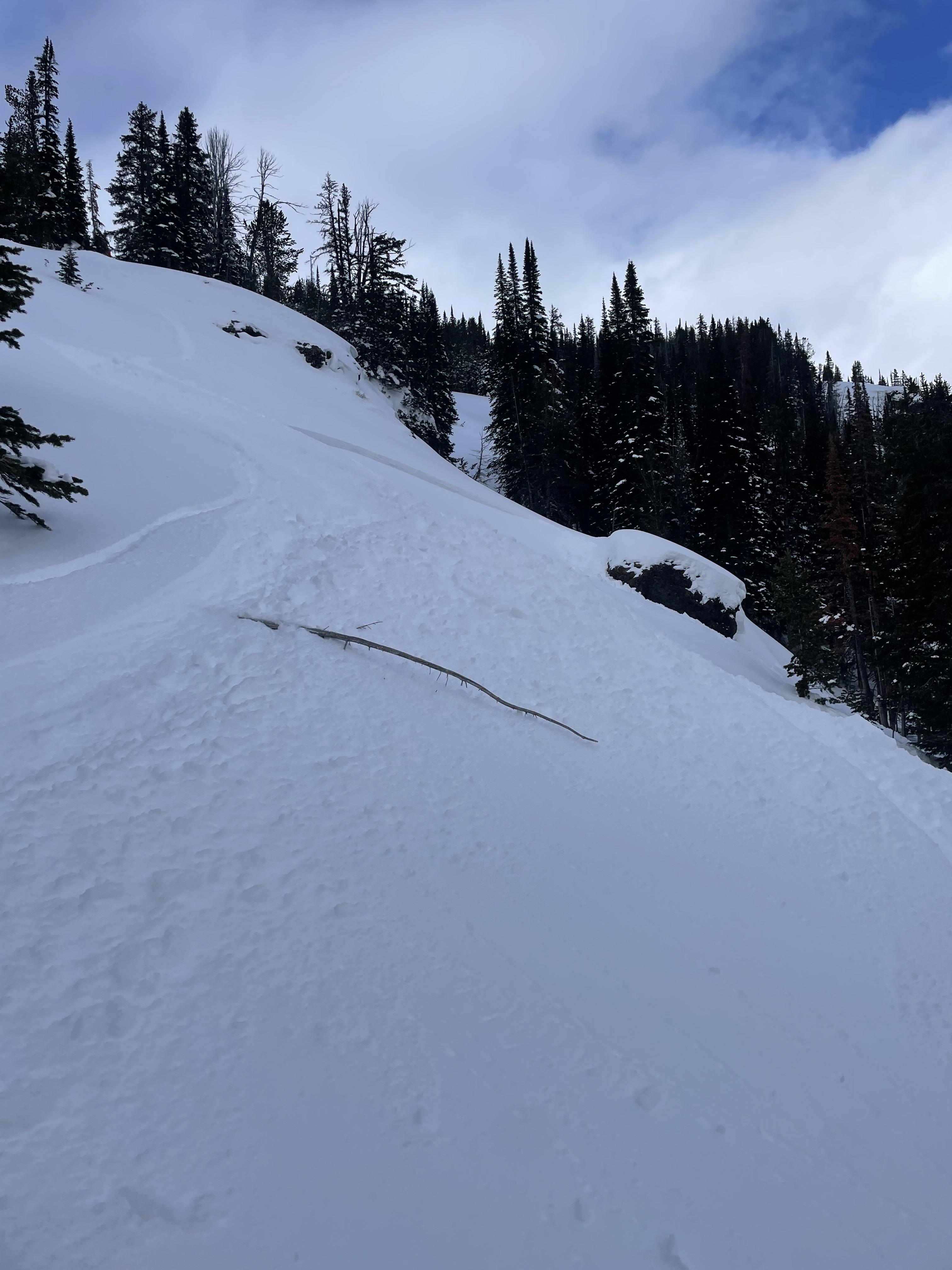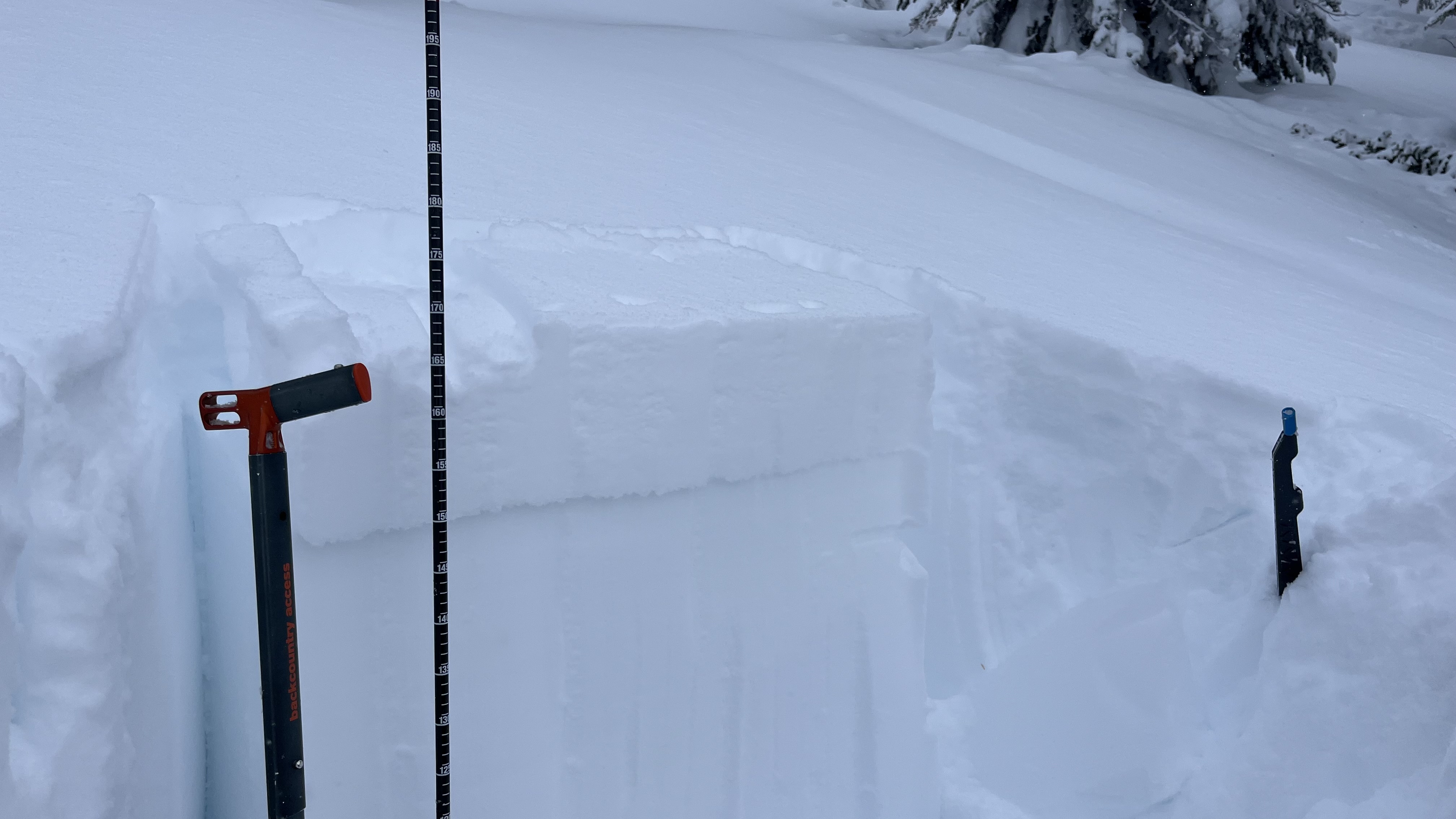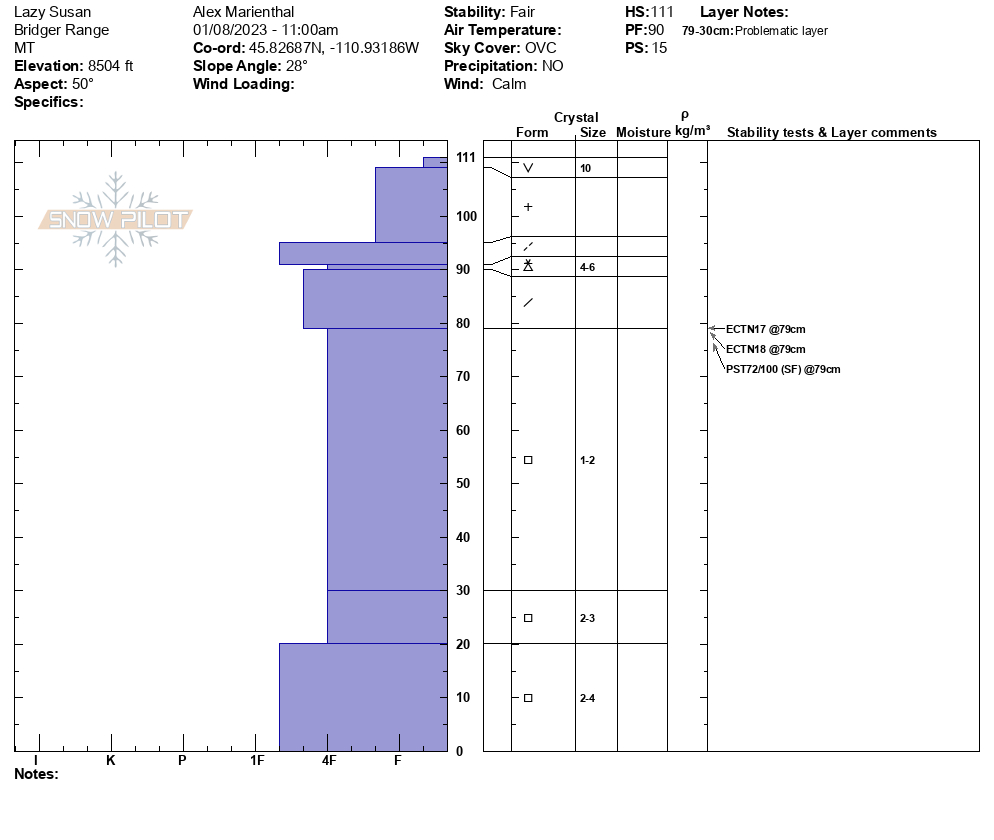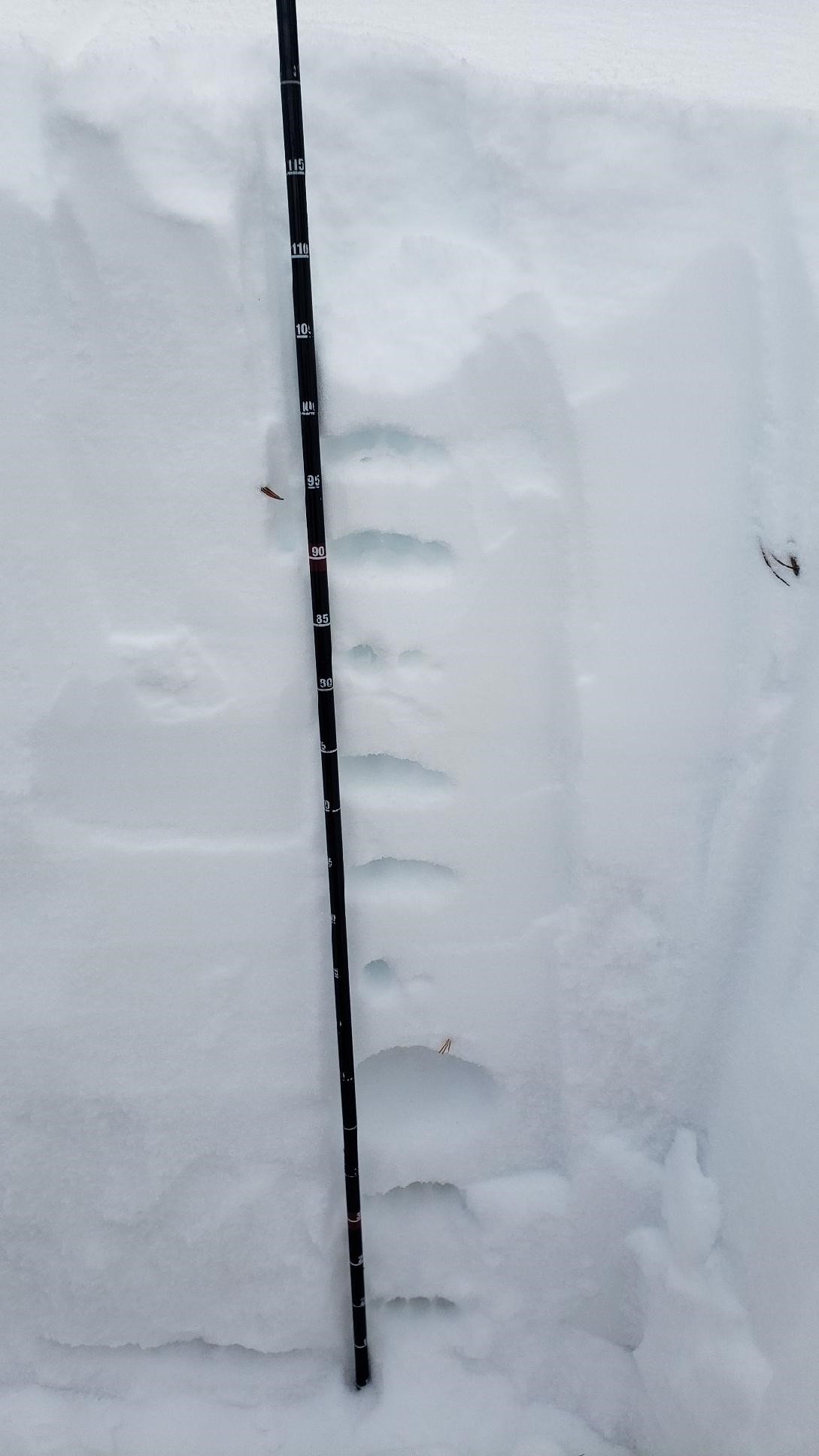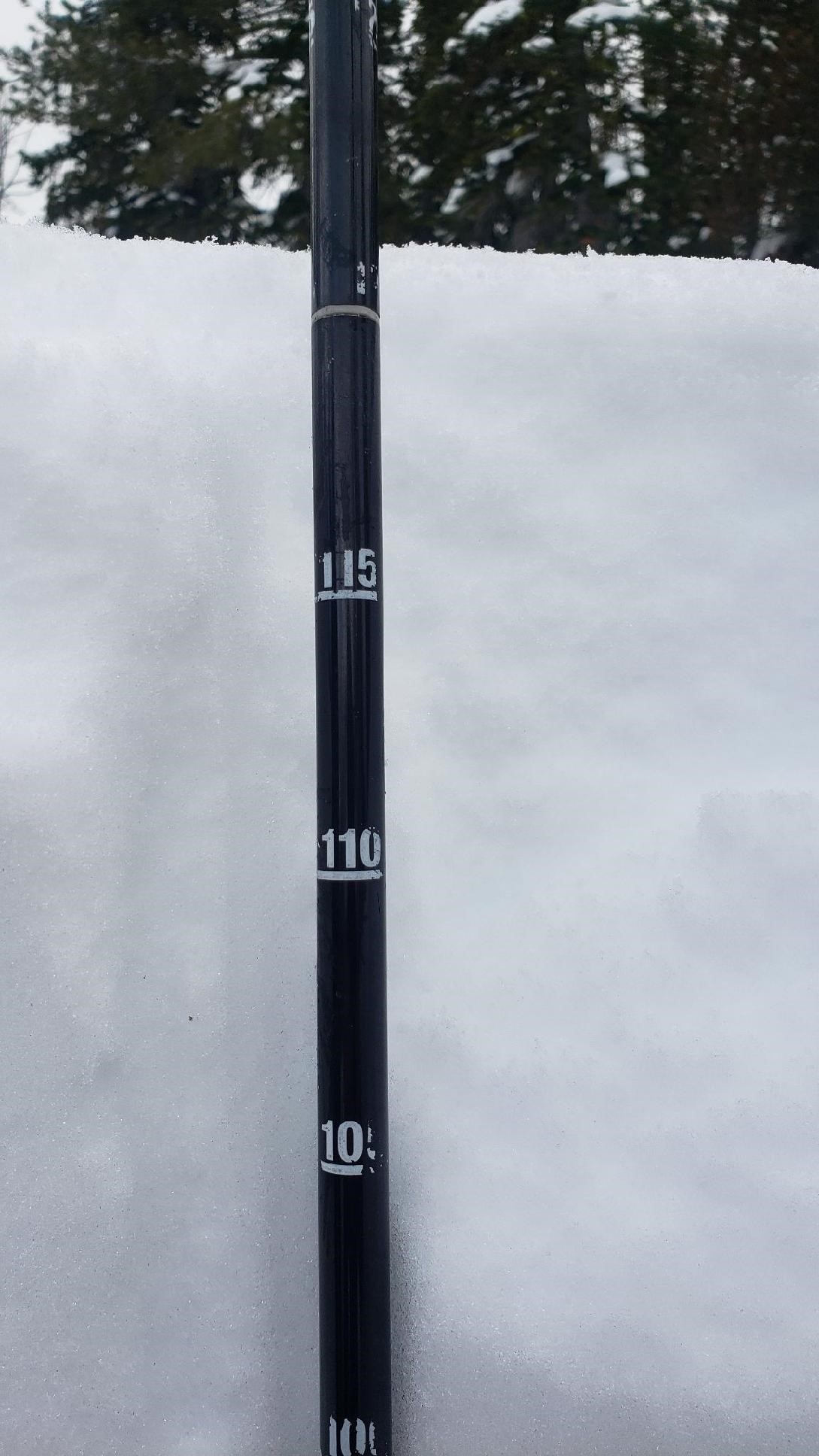Snow Observations List
From IG:
“Snowpack observation from 1/14/23
Northern Bridgers-Frazer Basin
Chute skiers left from the exit chute/sled access boundary on ridge.
Skied a more wind protected N facing chute and experienced stability skiing. Did 2 ski cuts before entering as well as doing a shovel shear on the top ~2ft of snowpack. No clean shear for the test or other observations of instability. As a result we skied.
Decided to start skiing up another, more open face to the E and stopped to dig about 1/3 of the way up once it started to get a little steeper. Dug on a Due N slope at 8430 ft. Snow depth was 205 cm from base. Column test failed at CT11 and CT15 at 175 and 135cm from base respectively. Was a clean break. Conducted an ECT which went at ECTP12 and 14 at the same depths. We skinned off the aspect and skied conservative lines the rest of the day.”
We rode in 1st, 2nd, and 3rd Yellowmules into the head of Muddy Creek today. At the 1st Yellowmule we found punchy, weak snow in several places. This is a sign that the snowpack is continuing to facet near the ground. The snow seemed more faceted than it was the last time we were in Buck. We saw a new layer of surface hoar on the snow surface all over Buck Ridge, which could be a problem in the future. We also found a layer of buried surface hoar 8-12” below the surface throughout Buck.
We dug at the head of Muddy Creek, and we found 160 cm (~5 feet) of snow on a north aspect. We got an ECTP8 on a surface hoar layer 10” below the snow surface. Where we dug was near a ridgeline, and the surface hoar was intact despite this area getting wind. When deciding to get into steeper terrain riders and skiers should assess for instability with an ECT at this layer, and they should still be wary of the weak, sugary snow at the bottom of the snowpack.
Started a small wind slab avalanche on an isolated rollover about 2/3 of the way down the face of elephant mountain yesterday (Thursday January 12th). Broke a few inches deep, about 8 feet wide, and ran less then 100 ft.
Full Snow Observation ReportToday my partner and I set out to ski Divide Peak and then re-ascend to connect the ridge over to 'Fat Maid' in Maid of the Mist basin. On our way up Divide peak, a hasty pit yielded poor results so we decided to bail on the main SE Gully that leaves from the summit. We still skied down from the shoulder, in the trees, and continued on our plan to head back up and over to Maid.
While skiing down 'Fat Maid' I triggered a shallow wind slab, after I was about 3/4ths of the way down the couloir. The slide broke to my left as I entered a wider section of the run, that holds a small perched bowl feature (which is what ripped out). The slide didn't propagate out into the main couloir, so the debris never impacted me. Even if it had, I don't think it would've been big enough to knock myself or any other skier off their feet. The slide was about 1/2 the width of the couloir and ran out to about 3/4ths of the apron's length (R2 D1?). The crown was 1-3" deep and maybe 30-40' wide. Had the wind slab been larger, or impacted one of the thin faceted layers mid-pack (like the one that scared us off Divide Peak) it could've been a different story. Thought it'd be good for people to consider heading into the weekend and unsettled weather. The picture is kinda hard to see so I did quickly draw the crown on the same image, but will send you the original as well.
On another note, we found an impressive amount of surface hoar, widespread, even in alpine areas exposed to sun and wind. Hopefully it get knocked down before the next storm!
Full Snow Observation Reportside hilled off of two top trail and broke small slab off
Full Snow Observation ReportWe rode to ski hill first, and we dug a pit on the NE aspect near the top of the slide path. The HS was 160 cm (5 feet). We found buried surface hoar under the 10-12” of new snow, and we got an ECTN13 on this layer. Next we rode to the old weather station, and the HS was 5.5’. We found the surface hoar in this pit too, but it did not propagate during our ECT. Despite these two results, skiers near Hebgen Lake found the surface hoar layer, and they had an ECTP3 and 6 on that layer. They also noted an ECTP26 on depth hoar near the bottom of the snowpack. Although the surface hoar isn’t propagating on every slope in the Lionhead Range, it is possible for it to propagate on other slopes in the range. With this buried surface hoar and facets near the ground riders and skiers should continue to carefully assess the snowpack before stepping out into steeper terrain.
Full Snow Observation ReportObserved widespread surface hoar growth (up to 2mm) along the Bradley Meadows uptrack. E-SE from 7400-7800’.
Full Snow Observation ReportToday on a west aspect around 7,835' in the Bridgers, near the top of Texas Meadows my party had test results of CT28 (SC) and ECTP25 both at 20 centimeters up from the ground. Snow pits my party dug on other aspects in the area had unremarkable results.
Full Snow Observation ReportStarting at Bear Basin trailhead toured into Middle Basin topping out at the highpoint on the ridge. We saw no signs of snow instability throughout the day. The temperatures were warmer than expected in the morning, the afternoon brought cooler temps and a little snow. The skiing was suprisingly good in places and wind affected in others.
Full Snow Observation ReportToday we had a question that needed answering: What is the distribution of the surface hoar? We dug in 5 places on different aspects and elevations and the answer was, “Everywhere.” But the SH is small and you can’t see it in the pit wall. It is buried about 20-35 cm deep. It will need more weight on it to get it to go. If a person was not looking for it it would be hard to find without an ECTP or Q1 fracture. I’m worried about areas with a slightly beefier slab, like what we found in Henderson Bench yesterday. Propagation and human triggering seems possible in these spots, but they are few in number. We found some thin spots and felt the sled bog down in the facets, which is issue #2. Triggering avalanches from thinner areas is still on our radar and may be for most of the winter.
Full Snow Observation ReportFrom Facebook: High Mountain Adventures snowmobile rental reported one of their renters triggered a slide on the waterfalls (Mt Jefferson/Sawtelle).
Full Snow Observation ReportPhoto attached of a fresh natural avalanche, just south of Cooke City today. It appears to have run last night or this morning. (photographed at noon)
we skied up to 9230 on a south slope of Miller Ridge in sheep creek basin. Intermittent clouds and sun, no wind. Much wind affected snow, cross loading. 2-4 inches of fresh snow. HS at 9000 was 100-110cm. Started finding wind slab on rotten base at about 8900 then at 9200 where slope steepened we observed 3-5 foot shooting cracks and turned around. Slope was 27-35. Had climbed thru whitebark regrowth from 88 fire.
We had good visibility and rode to Lulu to look at an ava that was triggered yesterday, a small cornice collapse. The one on Chimney Rock (triggered 2 days ago) was not big, but more indicative of weak layers at the ground. Chimney was 2 slides side-by-side, mid-slope, that likely went at the same time. These likely broke on facets near the ground. The snowpack was thin there. We then rode to Wolverine and Abundance. We saw a new snow slide on Wolverine in the deep cleft on the face. We dug on the shoulder of Abundance (HS 200+) and did not get anything remarkable in our stability test. We then rode to Henderson Bench. There was one small slide off the Henderson ridge by the radio hut. We dug off the bench and got a surprising ECTP 11 on surface hoar buried 30 cm under. Crystals were not big (2-4mm) and you could not see it in the pit wall, but the ECT sure popped it out.
Full Snow Observation ReportSnowboarder triggered this slide on a rollover on East Republic. Reportedly ran 80' wide, 1-1.5' deep. No one was caught.
Full Snow Observation ReportThere was 4 inches of new snow in Taylor Fork, and there was wind drifting in several places. We rode to the wilderness boundary to dig a pit. We were on a south aspect at 8,800’. HS 125cm (~4 feet), ECTN5 on surface hoar under the new snow, ECTN21 on facets 1.5 feet below the surface, ECTN 28 on facets near the ground. We rode past the Otter Slide to dig on a north facing aspect, and we had an ECTP5 on buried surface hoar. There was 6” of new snow on top of the surface hoar layer that propagated. While leaving Taylor Fork this afternoon it was beginning to snow. The additional snow in the forecast will likely make this surface hoar layer more reactive now that it is buried. Additionally, the poor structure throughout Taylor Fork could make the deeper weak layers more reactive.
Full Snow Observation ReportWe exited Bridger Bowl via the ridge and dug a pit at the top of Lazy Susan near The Ramp. It was 111 cm deep and full of facets. The lower half was facets, and the top was faceting, and there was surface hoar. We had ECTN17 and 18 at 79cm. Felt weak, but generally stable. You could trigger an avalanche somewhere, but danger is decreasing without new snow and wind-loading.
Full Snow Observation ReportSnowmobiled to 8200ft then skied up to 9000ft. Dug a snow profile to ground on NE aspect at 8800ft. Height of Snow was 120cm (4 feet). Multiple weak layers in the snowpack including one about a foot down and a thicker layer of faceted sugary snow in the bottom 2 feet of the snowpack near the ground. ECTN29 on a crust and small grained facets about a foot down from the surface, however that slab layer released when a shovel was put behind it with a sudden pop and very little friction, see grainy photo. Surface was faceting old powder which could be another weak layer when buried. Not very reactive in this spot at the moment likely due to lack of new snow in a while. However generally poor snowpack structure is not reassuring and will need to watch when this snowpack gets rapidly loaded by new snow or wind blown snow.
Full Snow Observation ReportObserved recent small wind slab avalanches under the ridgeline as well as one larger slide that broke on weak snow near the ground, likely cause by cornice fall.
Full Snow Observation Report